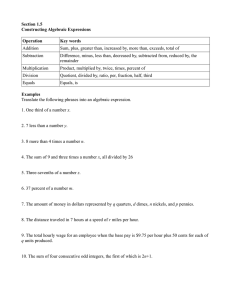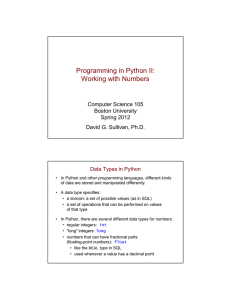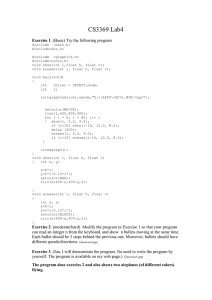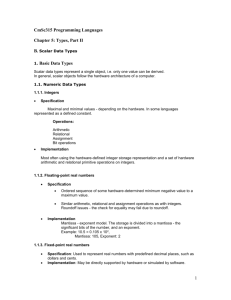Programming in Python II: Working with Numbers Computer Science 105 Boston University
advertisement
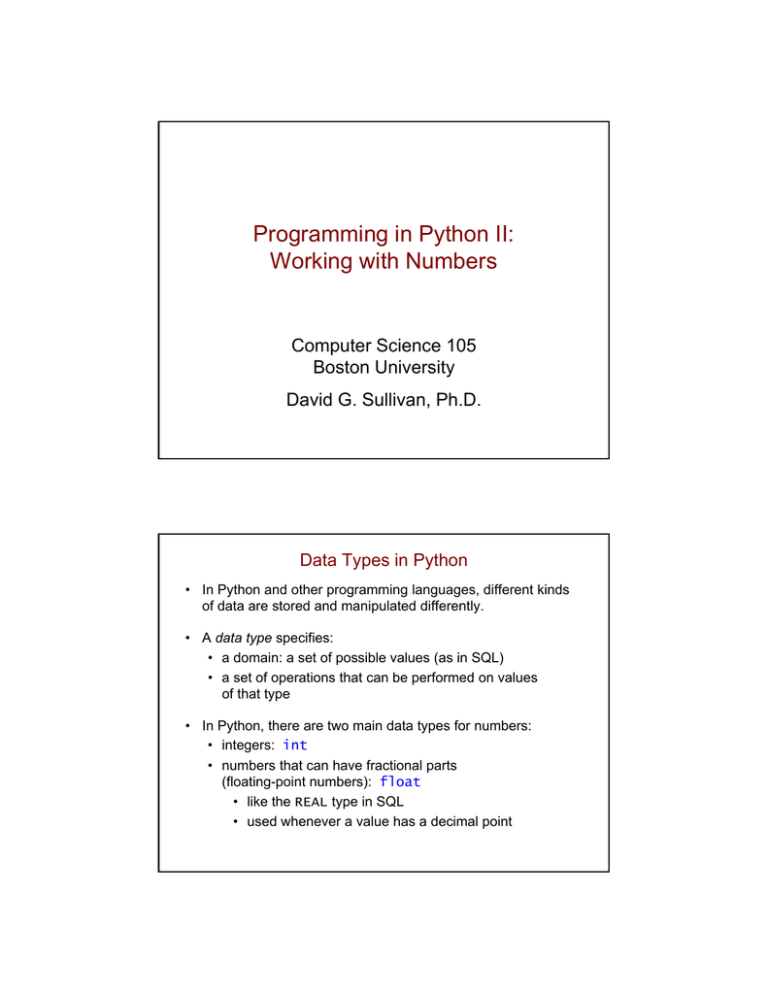
Programming in Python II: Working with Numbers Computer Science 105 Boston University David G. Sullivan, Ph.D. Data Types in Python • In Python and other programming languages, different kinds of data are stored and manipulated differently. • A data type specifies: • a domain: a set of possible values (as in SQL) • a set of operations that can be performed on values of that type • In Python, there are two main data types for numbers: • integers: int • numbers that can have fractional parts (floating-point numbers): float • like the REAL type in SQL • used whenever a value has a decimal point Data Types in Python (cont.) • To determine the type of a value, we can use the built-in type() function. • examples: >>> type(12) <class 'int'> >>> type(3.1495) <class 'float'> >>> type(3.0) <class 'float'> >>> type(2 ** 100) <class 'int'> >>> foo = 100 >>> type(foo) <class 'int'> >>> type(input) <class 'builtin_function_or_method'> Data Types and Variables • Variables in Python do not have a type, so it's acceptable to change the type of the value assigned to a variable. • examples: >>> value = 3.1495 >>> print(value) 3.1495 >>> value = 5280 >>> print(value) 5280 >>> value = 'Hello world!' >>> print(value) Hello world! Different Data Types Have Different Operations • Recall the list of operators for numbers: + addition subtraction * multiplication / division ** exponentiation % modulus: gives the remainder of a division 11 % 3 evaluates to 2 example: • There are really two sets of operators: one set for int values, and one for float values. • In most cases, the following rules apply: • if at least one of the operands is a float, the result is a float • if both of the operands are ints, the result is an int Two Types of Division • One exception to the rules on the last slide: the regular division operator (/) always produces a float result, regardless of whether the operands are ints or floats. • examples: >>> 5 / 3 1.6666666666666667 >>> 6 / 3 2.0 >>> 11.0 / 5 2.2 • The / operator is sometimes called the float division operator. Two Types of Division (cont.) • Sometimes, it's useful to perform integer division, which discards the fractional part of the result (i.e., everything after the decimal). • In Python 3, there is a separate // operator for integer division. • examples: >>> 5 // 3 1 >>> 6 // 3 2 >>> 11 // 5 2 • Note that the // operator truncates anything after the decimal. It does not round. Using the Division Operator • Recall our change-adder program: quarters = eval(input("number of quarters? ")) dimes = eval(input("number of dimes? ")) nickels = eval(input("number of nickels? ")) pennies = eval(input("number of pennies? ")) cents = quarters*25 + dimes*10 + nickels*5 + pennies print("you have", cents, "cents") • Let's change it to print the result in dollars and cents. • for example, 327 cents would print as 3 dollars, 27 cents cents = quarters*25 + dimes*10 + nickels*5 + pennies dollars = cents = print("you have", dollars, "dollars and", end=" ") print(cents, "cents") Type Conversions • There are built-in functions for converting to any numeric type: • float(n): converts n to a float • int(n): converts n to an int, discarding any fractional part • Examples: >>> int(8.72532) 8 >>> float(8) 8.0 >>> float(2**60) 1.152921504606847e+018 Type Conversions (cont.) • Using a type-conversion function does not change the type of the value stored in memory. • examples: >>> measurement = 3.7 >>> int(measurement) 3 >>> measurement 3.7 • How could we change the type of the value stored in memory? • this works because variables do not have a type Rounding a Number • round(n) rounds the number n to an integer: >>> round(8.5) 9 >>> round(8.49) 8 >>> round(2.8) 3 • round(n, d) rounds the number n to d places after the decimal. If n is a float, it remains a float. If n is an int, it remains an int. >>> round(8.7583, 2) 8.76 >>> round(8.7583, 1) 8.8 >>> round(8, 2) 8 >>> round(10.595, 2) 10.6 (note that non-essential 0s are not displayed) Python's Math Module • Python comes with a math module that contains definitions for a number of mathematical functions and constants, including: • sqrt(n): computes the square root of a number • trigonometric functions: sin(n), cos(n), tan(n) • constants: pi, e • To use them, we need to: • import the module • prepend the name of the module (e.g., math.sqrt(25)) >>> math.sqrt(25) # won't work before import …NameError: name 'math' is not defined >>> import math >>> math.sqrt(25) 5.0 >>> math.pi 3.141592653589793 Height Converter • Let's design and write a program that reads a height in centimeters and computes: • the height in inches (rounded to the nearest inch) • the height in feet, which any fraction of a foot expressed in inches • Example interaction: Enter your height in cm: 172 You are 68 inches tall (5 feet, 8 inches). • Conversion factor: 1 cm = 0.393700787 inches Height Converter (cont.) • Pseudocode: • Python code:

